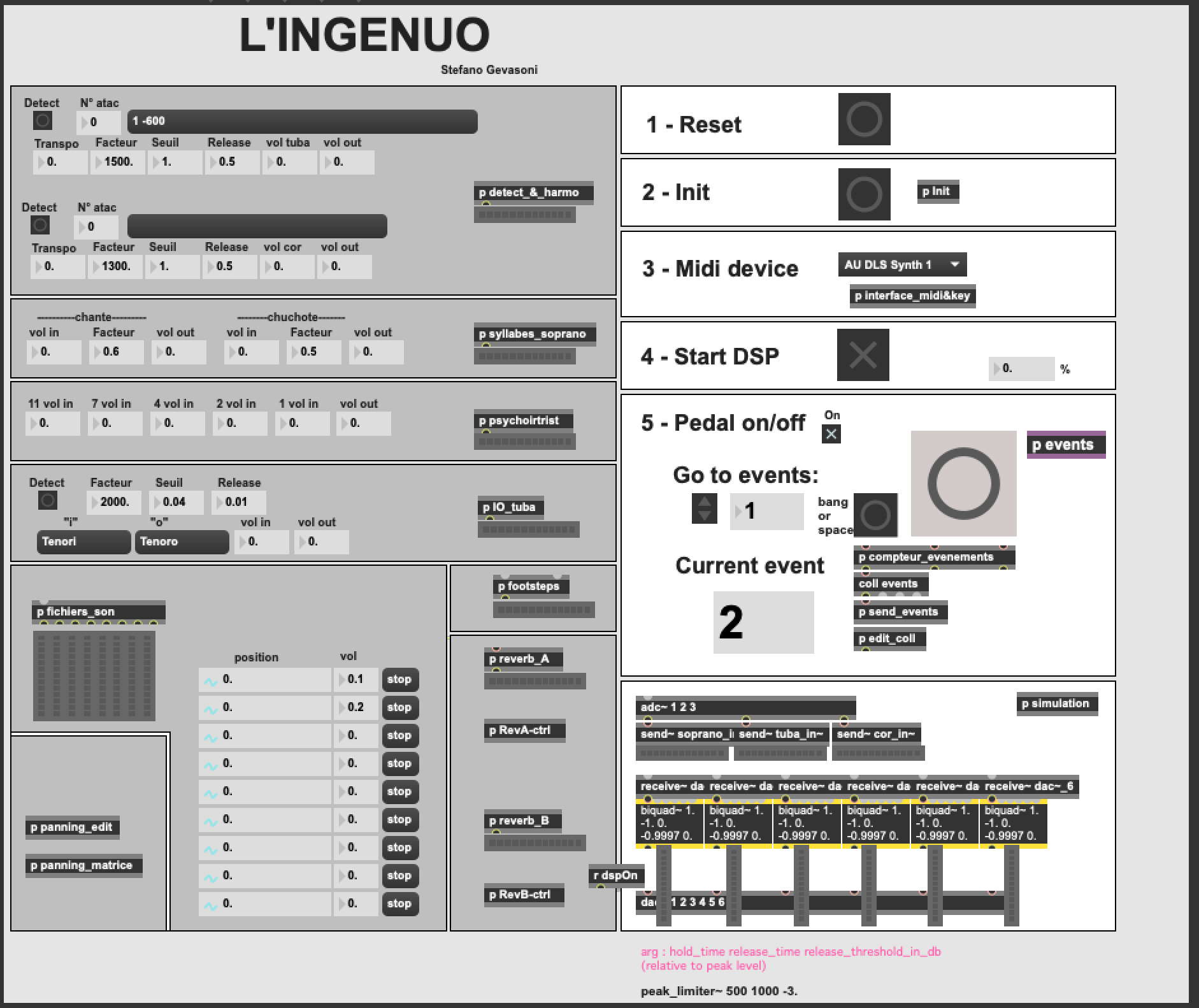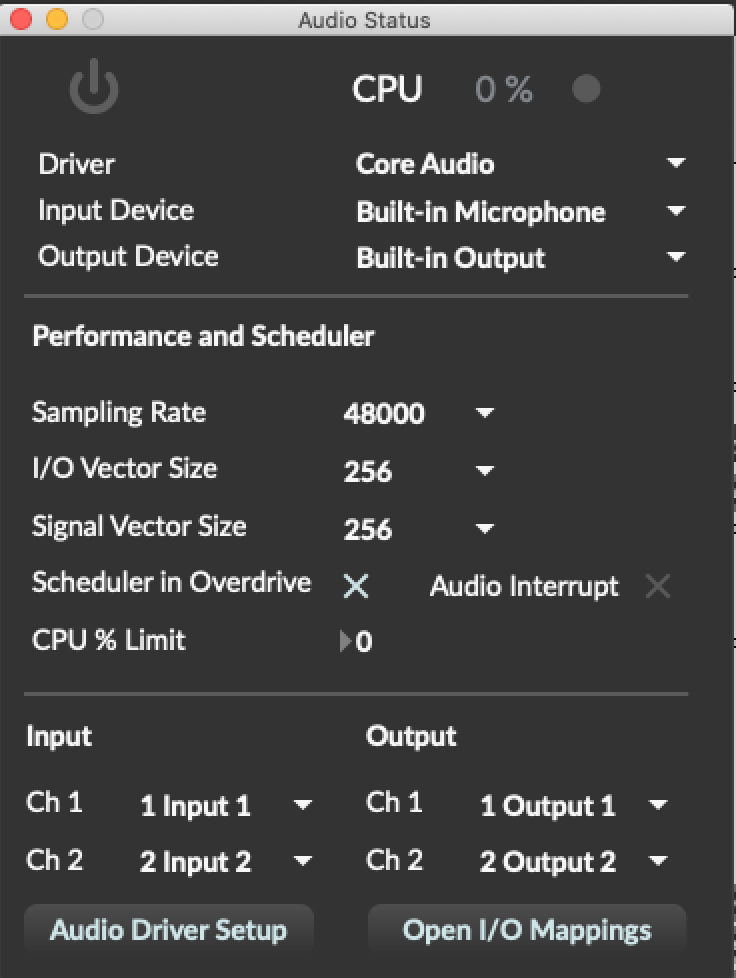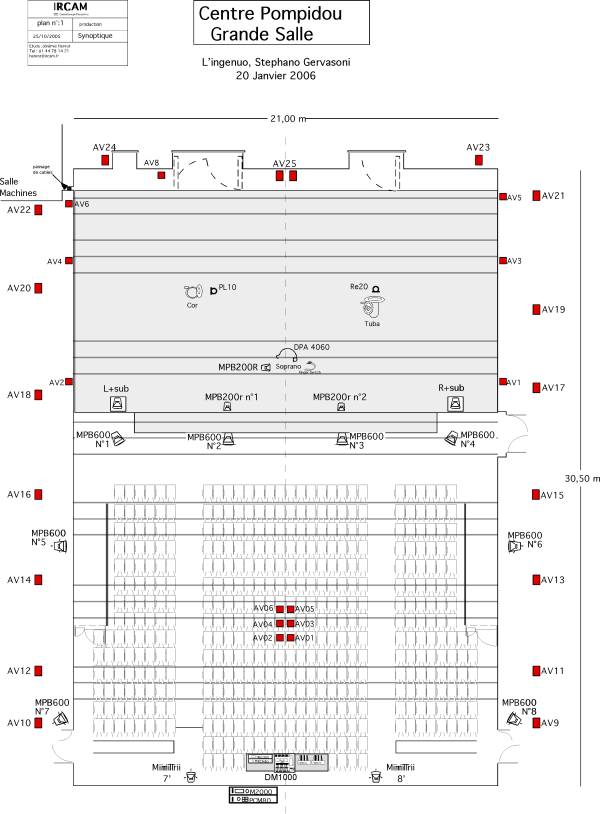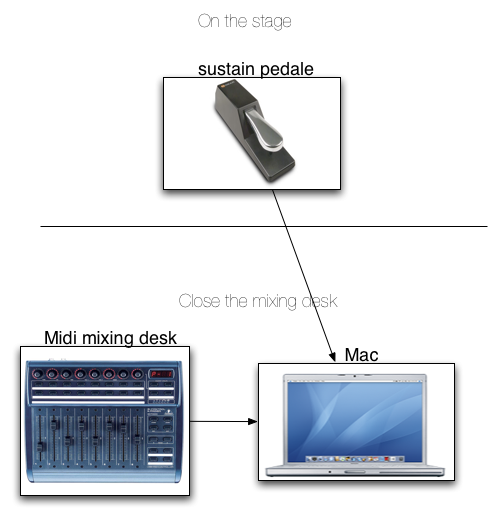Table of contents
Performance date: 20 janvier 2006
Documentation date: 6 juin 2019
Version state
Valid
Validation date: 9 janvier 2022
Executions dates of this version
- 20 janvier 2006,
Version documentalist
- meudic (Benoit.Meudic@ircam.fr)
Version realisation
- Stefano Gervasoni (Composer)
- Thomas Goepfer (Computer Music Designer)
- Jérémie Henrot (Sound engineer)
Version length
18 mnUpgrade Motivation
Max8 upgrade
Comment
Musical piece based on a poem from Toti Scialoja.
Written for soprano, horn, euphonium and live electronics.
Other version(s)
Detailed staff
- soprano solo, euphonium, cor
Channel details
- Number of input channel : 3
- Number of output channel : 6
Electronic equipment list
Computer Music Equipment
-
1 MacBook Pro - Apple Laptops
(Apple)
Mac os >= 12.12.8 -
1 Max 8 - Max
(Cycling74)
-
1 Hammerfall hdsp9652 - Sound Board
(RME)
[MIDI I/O:1] [Max frequency:96] [ASIO/Core Audio:1] [Port format:PCI] [ADAT:1] [Bit number:24] -
1 BCF 2000 - MIDI Mixer
(Behringer)
Used to control volume output for all treatments. [Automation:1] [Nb of channels:8] -
1 Footswitch / Sustain Pedal - Footswitch / Sustain Pedal
for Soprano [Hand activation:1] [Foot activation] [Port type:Finger]
Audio Equipment
-
1 RE 20 - Dynamic Microphones
(Electrovoice)
Euphonium [Directivity:cardio] [Dynamic:1] -
1 RE 10 - Dynamic Microphones
(Electrovoice)
Horn [Directivity:cardio] [Dynamic:1] -
1 DPA 4060 - Condenser Microphones
(DPA)
Soprano [Directivity:omni] [Static:1] -
1 HF System - HF System
(Sennheiser)
for Soprano -
1 MPB 600 - Passive Monitors
(Amadeus)
[Used for] [DAC number] -
1 DM1000 - Digital Mixers
(Yamaha)
[Mono input] [Stereo input] [Mic input] [Aux] [Bus] [Output] [Digital] [Analog] [Input]
Work related information
Premiere
- 26 février 1994, (première version pour voix, tuba, electronique et instruments ad libitum) Paris, Ircam, espace de projection
- 20 janvier 2006, Paris, Centre-Pompidou, grande salle
Publisher :
- Ricordi
Realisation
- Thomas Goepfer
Work length
- 15 mn
Useful links on Brahms
- L'Ingenuo pour soprano, euphonium, cor et électronique (1992-1994), 15mn
- Stefano Gervasoni
| File | Author(s) | Comment | |
|---|---|---|---|
| Download [1,3 Gio] | Patch Ingenuo-2019 | Benoit Meudic | max8 patch |
| Download [530,8 Mio] | Patch Ingenuo-divers | Benoit Meudic | simulation - recording - score |
| Download [231,1 Mio] | Patch uploads/Gervasoni/Ingenuo/ingenuo.zip | old patch |
Instructions
General informations
L’Ingenuo is a piece for voice, euphonium, french horn and real time electronics.
The electronics consists in soundfiles, harmonizers, resonators and spatialisation on voice, tuba (euphonium) and french horn.
The cues are trigerred with a midi sustain pedal by the tuba (euphonium) player.
Install - Installation Procedures
- copy the folder called Ingenuo-2019 on your hard disk drive.
- launch Max8.
- in the options menu, click on file preferences. Then add the folder Ingenuo-2019 (Cf. Fig. Files Preferences).
- quit Max8
- launch the file called Ingenuo-Max8

File preferences
Patch presentation
The concert patch main window is structured this way:
- on the left side : Interface for checking and modifying parameters of live treatments.
- detect_&_harmo : detect, count and harmonize attacks.
- syllabes_soprano : yin detection to separate voiced and unvoiced parts.
- psychoirtrist : make choir with 1, 2, 4, 7, or 11 voices.
- IO_tuba : detect attacks, and apply 2 resonators to make “I” and “O”.
- footsteps : sound files of foot steps.
- fichiers_son : sound files.
- reverb_A and reverb_B : 2 different reverbs.
- panning_edit and panning_matrice : panning.
- on the right side : Step by step initialisation.
A Midi mixing desk (like BCF2000 from Behringer) is used to control volume output from all treatments.

Ingenuo main window
Inputs/Outputs
There are 3 inputs for soprano, tuba and french horn.
There are 6 outputs: (dac 1..6 on loudspeakers 1 front left, 2 front right, 3middle left, 4 middle right, 5 back left and 6 back right)
Initialization
- Click in the reset bang.
- Click in the init bang.
- Choose the midi device for the midi mixing desk.
- Click to start DSP.
DSP should be set to sampling rate 48000, I/O vs 256, Svs 256, overdrive on, audio interrupt off.

- Check the midi pedal and click in the little toggle labelled “on”.
Now, the first pedal starts the patch.

Initialization part of the main window
Stage Setup Diagram

Loudspeaker Setup Diagram
MIDI setup
Midi connection diagram

Midi connection diagram
Midi mixing desk configuration
Midi mixing desk controls the “out” volume for all treatments :
- 1 - detect & harm
- 2 - syllabes soprano
- 3 - psychoirtrist
- 4 - IO tuba
- 5 - soundfiles
- 6 - footsteps
- 7 - RevA
- 8 - RevB

Midi mixing desk
© IRCAM

This documentation is licensed under a Creative Commons Attribution-NonCommercial-NoDerivatives 4.0 International License.
Version documentation creation date: 6 juin 2019 14:23, update date: 9 janvier 2022 18:45